Andrew Di Salvo, DVM, the inaugural Free-Ranging Wildlife Health Veterinary Resident with the CDFW Wildlife Investigations Laboratory and the UC Davis Karen C. Drayer Wildlife Health Center, shares a photo from each month of his first year…












Andrew Di Salvo, DVM, the inaugural Free-Ranging Wildlife Health Veterinary Resident with the CDFW Wildlife Investigations Laboratory and the UC Davis Karen C. Drayer Wildlife Health Center, shares a photo from each month of his first year…











An understanding of the demography, distribution, behavior, and genetic diversity of animal populations enables the California Department of Fish & Wildlife to properly manage species statewide. Capturing bighorn sheep provides an opportunity to place GPS and VHF collars, as well as collect biological samples (e.g. blood, nasal swabs, hair, feces). This accumulation of data will offer insight into bighorn sheep population dynamics, genetic diversity, and overall health.
From October through November of this year, CDFW participated in helicopter captures of multiple bighorn sheep populations. After ensnaring the sheep in a net, a capture crew member would exit the helicopter, secure the sheep by placing leg hobbles and an eye cover, and then either process the sheep in the field or place it in a carry bag for long-line transport to a base camp for processing. Processing at the base camp consisted of weighing the sheep, collecting morphometrics (body measurements), blood, hair, feces, and nasal swabs (for detection of Mycoplasma ovipneumoniae, a bacteria that can cause a fatal pneumonia), administering vitamin E and selenium injections, followed by GPS and/or VHF collar placement and ear tagging. Additionally, an ultrasound examination was performed to both determine body condition score by measuring the thickness of subcutaneous fat and particular muscle bodies, as well as check if any ewes were pregnant. Following processing, sheep were either released from the base camp or returned by helicopter to the capture site for release.
Up first on the schedule were the endangered Sierra Nevada bighorn sheep. Over the course of six days in the Sierra Nevada Mountains, a total of 34 sheep were captured, including seven rams, with 33 sheep receiving at least one VHF or GPS collar (33 VHF, 31 GPS). Operations then moved to the Sespe Wilderness Area within Los Padres National Forest to capture desert bighorn sheep that had originally been translocated to the area, part of their historic range, back in the mid-1980s. This was quite the unique opportunity in that these sheep were thought to be all but gone from the range in the early 2000s and were only recently seen on the landscape. Furthermore, the population hadn’t been handled in the more than 30 years since their initial reintroduction. A total of 22 sheep were captured over three days, including 10 rams, with 19 sheep receiving at least one VHF or GPS collar (15 VHF, 13 GPS). The Sespe captures were followed by four days in Anza Borrego State Park and Palm Desert, CA for field processing of desert bighorn sheep from the Peninsular Ranges. These efforts yielded 42 total captures, all ewes, with each sheep receiving at least one VHF or GPS collar (18 VHF, 26 GPS). The capture team then moved to the Mojave Desert and Death Valley National Park for seven days of desert bighorn sheep processing, yielding 71 total captures, including 18 rams, with all but two sheep receiving both a VHF and GPS collar (69 VHF, 69 GPS). Capture operations wrapped up in the White Mountains just outside of Bishop, CA, where 33 desert bighorn sheep were captured over four days, including 12 rams, with all but two sheep receiving both a VHF and GPS collar (31 VHF, 31 GPS).
In less than one month, CDFW captured 202 bighorn sheep, placed 166 VHF and 170 GPS collars, and collected abundant biological samples that will be closely studied for the next few years. The information acquired through analysis of the biological samples, as well as the continual spatial data that the collars will generate, will provide CDFW with valuable material by which they can make educated and well-informed decisions regarding the management of the state’s bighorn sheep populations.
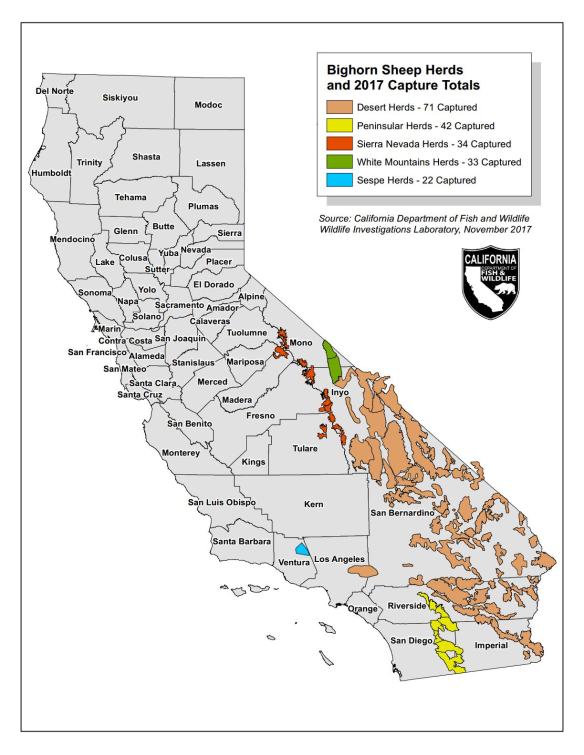
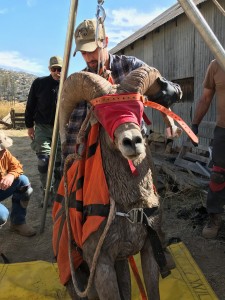
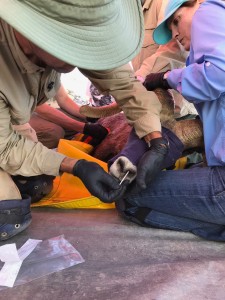
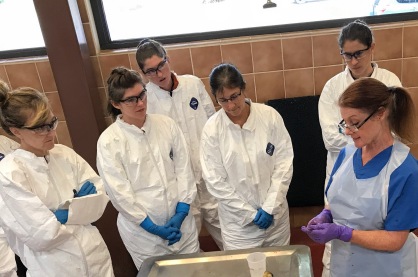
Dr. Janet Moore (California Animal Health and Food Safety Laboratory – San Bernardino) instructs CDFW field staff in bighorn necropsy techniques.
On Thursday, September 14, 2017, the California Animal Health & Food Safety Laboratory (CAHFS) and the California Department of Fish & Wildlife (CDFW), Wildlife Investigations Laboratory (WIL) hosted a bighorn sheep necropsy course at the CAHFS Diagnostic Laboratory in San Bernardino, California. Assisting with the course were Dr. Peregrine Wolff and wildlife technician Chris Morris from the Nevada Department of Wildlife (NDOW). In attendance were CDFW regional biologists, scientific aides, and veterinarians. The course served as an opportunity for attendees to learn how to recognize, describe, and collect samples from bighorn sheep during field necropsies. It also provided a reminder of how important it is to keep domestic sheep populations separated from free-ranging bighorn populations in order to maintain healthy herds.
After introductory remarks from Dr. Ben Gonzales (CDFW WIL), Dr. Francsisco Uzal (CAHFS) led a discussion on how to describe macroscopic lesions (i.e. distribution, size, shape, demarcation, color, consistency, contour) along with a review of the pathology of a few select domestic and bighorn sheep diseases. Dr. Francisco Carvallo (CAHFS) then expanded upon the main respiratory pathogens of bighorn sheep, which includes lungworms (Protostrongillus spp.), bacteria (e.g. leukotoxin-positive Pasteurellaceae, Mycoplasma ovipneumoniae), and viruses (e.g. respiratory syncytial virus, parainfluenza-3 virus). Following an important review of appropriate PPE (personal protective equipment) to utilize during bighorn sheep necropsies led by Meridith Rhea (CAHFS), Dr. Peregrine Wolff (NDOW) led a discussion on field necropsy techniques and nasal tumors of bighorn sheep to wrap up the morning session.
The afternoon was spent observing a bighorn sheep necropsy demonstration performed by Janet Moore (CAHFS) and Akinyi Nyaoke (CAHFS). Attendees were then given the opportunity to perform their own bighorn sheep necropsies under the guidance of the aforementioned instructors, along with assistance from Karina Fresneda (CAHFS), Patricia Gaffney (CAHFS), Dr. Francsisco Uzal (CAHFS), Dr. Francisco Carvallo (CAHFS), Dr. Peregrine Wolff (NDOW), Chris Morris (NDOW), Dr. Brandon Munk (CDFW WIL), Dr. Ben Gonzales (CDFW WIL) and Dr. Andrew Di Salvo (CDFW WIL).
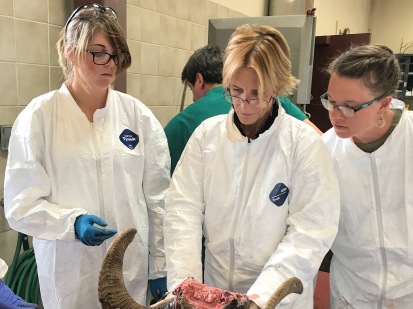
Dr. Peregrine Wolff (Nevada Division of Wildlife) demonstrating locating sinus tumors in bighorn.
For the past 5 years, the WIL and it’s partners the Endangered Species Recovery Program (ESRP), UC Davis, CDFW-Region 4, USFWS, and the California Living Museum (CALM), have been working together to help San Joaquin kit foxes living in Bakersfield gain the upper hand during a fatal epidemic of sarcoptic mange.

Healthy male San Joaquin kit fox, #6833, in January 2017.
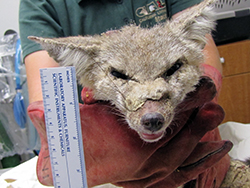
The same male San Joaquin kit fox, #6833, months later in July 2017 – after becoming infested with mange.
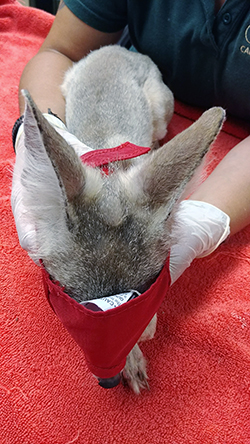
Male San Joaquin kit fox, #6833, a month after receiving treatment for mange while at the California Living Museum, CALM. CALM is a permitted wildlife rehab facility in Kern County.
WIL environmental scientist and UC Davis graduate student, Jaime Rudd, was recently featured in a story about some of the ongoing work and it’s challenges. More about the research can be found on CDFWs Science Institute’s “Science Spotlight” website:
Additional information about the outbreak, including a recent publication, can be found by following the link.
Last September, a gray fox was found dead at a residence in Inverness in Marin County with no signs of trauma. Since the residence was adjacent to the Point Reyes National Seashore, the National Park Service investigated. The gray fox was sent to their lab in Colorado and found to have unexplained hemorrhaging in the brain and lungs with no signs of trauma. These are classic signs of anticoagulant rodenticide poisoning, so the liver was sent to be analyzed by the California Animal Health and Food Safety Laboratory in Davis. The liver contained a toxic combination of three different second generation anticoagulant rodenticides. These rodenticides – brodifacoum, bromadiolone, and difethialone – are only legally used by pest control professionals for rodent control in and around man-made structures. After eating these baits, rodents remain mobile for several days and can be eaten by wildlife or pets.

Gray fox at the Point Reyes National Seashore. Photo: NPS/Bernot
Members of the public cannot obtain these materials over the counter. Due to their harmful impacts to wildlife second generation anticoagulant rodenticides became restricted use materials in California in July 2014.
To protect local wildlife, the National Park Service and the California Department of Fish and Wildlife urge safer rodent control such as exclusion and trapping. It is also recommended that residents ask any pest control company that they employ not to use these materials on their property. The two agencies are teaming up to get the word out locally to prevent another incident near Point Reyes National Seashore. However, this is not a unique situation. Monitoring in California has found that the majority of predators and scavengers, such as foxes, bobcats, mountain lions, coyotes, and raptors, are still being exposed to these materials.
Be a good neighbor to your local wildlife and help spread the word!
To learn more, please visit the CDFW webpage:

Captively bred Amargosa voles. Photo credit: Nora Allen
Since 2014, CDFW-WIL has partnered with UC Davis in order to create and maintain a breeding colony of Amargosa voles essential to the recovery of the species. If interested in learning more about the history and progress of the colony, please read more here. Below is a video showing a few of the vole pups bred in captivity (Credit: Janet Foley).
In the Spring of 2016, CDFW (WIL and Region 6), UC Davis, BLM, USFWS, and many volunteers partnered to restore a key habitat patch utilized by the Amargosa vole. This habitat patch used to sustain the highest density of Amargosa voles in the world, but in 2010 it began to deteriorate due to changes in hydrology. The Amargosa vole team worked diligently to restore the water supply and reinvigorate vegetation growth at the marsh. Learn more about the Amargosa vole project.
Recent work from Amanda Poulsen (UC Davis) in partnership with researchers at CDFW-WIL has been published in the Journal of Wildlife Diseases. This work examined the prevalence and potential impacts of toxoplasmosis in the wild Amargosa vole population. To access the paper abstract, click here.
Full reference: Amanda Poulsen, Heather Fritz, Deana L. Clifford, Patricia Conrad, Austin Roy, Elle Glueckert, and Janet Foley (2016) Prevalence and Potential Impact of Toxoplasma gondii on the Endangered Amargosa Vole (Microtus californicus scirpensis), California, USA. Journal of Wildlife Diseases In-Press.
CDFW Wildlife Investigations Laboratory has confirmed that another turkey vulture has been poisoned by the veterinary euthanasia drug pentobarbital near Inverness, in Marin County (see map below). The massive bird with its six-foot wingspan has recovered and will be released near Inverness (Marin County) on Tuesday, August 11 at 2 p.m. Reporters who would like to see this vulture return to the wild should call 415-806-8637 Tuesday for the exact location.
CDFW confirmed pentobarbital exposure in six turkey vultures in San Rafael in 2014, but the source of the exposure remains unknown. Those birds were taken to the wildlife hospital operated by the nonprofit WildCare in San Rafael. WildCare is a CDFW-approved wildlife rehabilitator.
Wildlife officials are concerned that the July 2015 admission of an additional pentobarbital-poisoned vulture to WildCare indicates that more wildlife are at risk.
Pentobarbital is a drug used by veterinarians to euthanize companion animals, livestock and horses. If the remains of animals euthanized with pentobarbital are not properly disposed of after death, scavenging wildlife – such as turkey vultures and eagles – can be poisoned. Veterinarians and animal owners are responsible for disposing of animal remains properly by legal methods such as cremation or deep burial.
Turkey vultures are protected by the federal Migratory Bird Treaty Act and California Fish and Game Code. Euthanized remains that are not disposed-of properly are a danger to all scavenging wildlife.
CDFW asks members of the veterinary and livestock communities to share this information with colleagues, to prevent additional poisoning. WildCare also asks the public to pay attention to grounded turkey vultures and other raptors and scavengers.
Pentobarbital-poisoned birds appear to be dead. They have no reflex response and breathing can barely be detected. The birds appear intact, without wounds or obvious trauma. Anyone finding a comatose vulture should call WildCare’s 24-hour Hotline at (415) 456-SAVE (7283) immediately. Anyone with information about possible sources of pentobarbital-contaminated animals should contact the California Department of Fish and Wildlife at (916) 358-2954.
Toxicological analysis was performed by the California Animal Health and Food Safety Laboratory in Davis.
Be on the look out for band-tailed pigeons! Reports this month indicate band-tailed pigeons, California’s only native pigeon, are utilizing areas where they haven’t been in years. Observers have reported flocks of 50 to 100 birds in locations where pigeons haven’t been seen in at least 15 to 20 years. These seemingly erratic movements are directly tied to available food resources. During the winter, band-tailed pigeons feed primarily on acorns. They are one of the few species that actually swallow acorns whole!
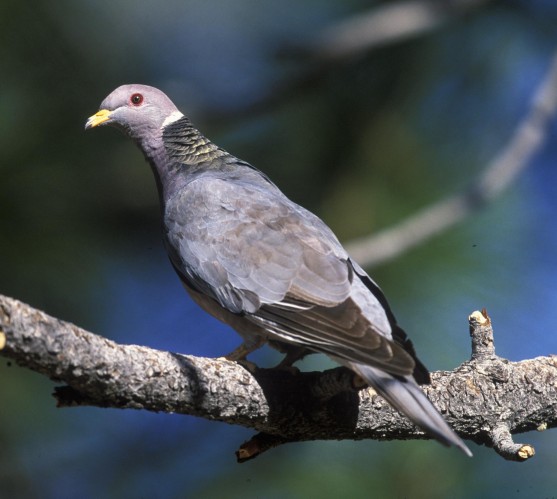
Adult band-tailed pigeon showing the characteristic white crescent and iridescent greenish-bronze patch of feathers on the hind-neck. Photo by Gary Kramer, 2008.

Acorns on a coast live oak (Quercus agrifolia), a favorite wintertime food of band-tailed pigeons. Photo by Krysta Rogers, 2011.
Acorn productivity fluctuates among oak species and between years. In some years, oaks may produce large quantities of acorns, in other years acorn production can be spotty. If acorns are not available, pigeons will rely on other food items such as madrone berries or pine nuts. However, the availability of all these plant foods are dependent upon weather conditions including temperature and the timing of rain, which leads to changeable food resources. Band-tailed pigeons must be adaptable to these variable conditions and seek out food resources across the landscape.
The observations of pigeons using “non-traditional” locations this winter may possibly be influenced by recent drought conditions. In Sacramento County, acorn productivity this season was very high and, in fact, bird watchers reported seeing flocks of band-tailed pigeons along the American River during fall migration. In contrast, a recent trip to the Los Padres National Forest in Monterey County, a location known to be especially reliable for both acorns and band-tailed pigeons, revealed neither acorns nor band-tailed pigeons this winter! Instead, pigeons were observed at lower elevations where abundant food was available.
Also likely related to drought, was the increased incidence of Trichomonosis in band-tailed pigeons this summer. Trichomonosis is a disease caused by a single-celled microscopic protozoan parasite, Trichomonas gallinae. The parasite lives in the mouth and throat of infected birds, causing caseous (“cheese-like”) lesions to develop in the birds’ mouth or esophagus. The lesions eventually block the passage of food, causing the bird to become weak and emaciated. Infected birds die from starvation, or suffocation if the lesions block the airway.

An adult band-tailed pigeon showing signs of infection with Trichomonas parasites. Notice the drooped wings, ruffled feathers, and open-mouth breathing. Photo by Krysta Rogers, 2012.
Band-tailed pigeons are highly susceptible to infection with Trichomonas gallinae. Traditionally, large-scale die-offs occur during the winter months, in some years. However, this year the Wildlife Investigations Lab received reports of increased mortality of band-tailed pigeons in several locations along the central California coast between May and August. Drought conditions likely resulted in increased contact between individual birds at limited food or watering sites, resulting in rapid spread of disease. This increased mortality of band-tailed pigeons is concerning because the band-tailed pigeon population has been declining for the past 40 years. Die-offs due to Trichomonosis can remove hundreds to thousands of pigeons from the population in a relatively short period of time.
This winter, be on the look out for band-tailed pigeons in your area. If you see pigeons, enjoy the spectacle, it may not occur at that location for another 20 years! And if you happen to observe pigeons that appear sick, such as showing signs of weakness, labored breathing, breathing with their bill open, drooling, reluctance to fly when approached, or are dead, you can help by reporting the mortality to the Wildlife Investigations Lab.
If you have any questions, or would like to report sick or dead band-tailed pigeons, contact Krysta Rogers at 916-358-1662.